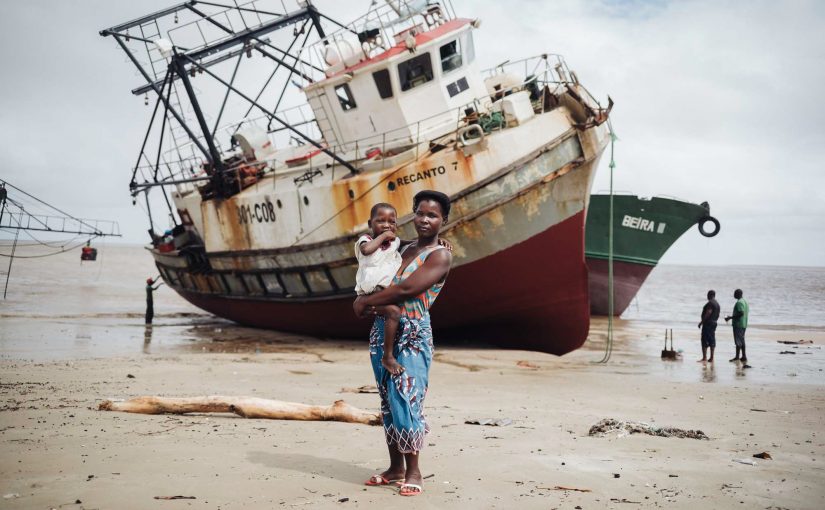Mozambique: Minister Muchanga in Geneva attending World Summit on the Information Society, AI for ...
Mozambique: Aid to cyclone Idai victims 1,000 times more than preparatory actions – IFRC

Photo: Benjamin Suomela/Finnish Red Cross
Aid to those affected by Cyclone Idai in central Mozambique has cost almost a thousand times more than disaster preparedness and prevention measures, according to International Federation of Red Cross and Red Crescent Society (IFRC) calculations.
On the eve of the United Nations 2019 Global Platform for Disaster Risk Reduction Conference, which begins this Wednesday in Geneva, Switzerland, the IFRC concluded that, in Mozambique, Red Cross and UN relief operations alone cost about 315 million Swiss francs (EUR 278 million).
This amount amounts to nearly 1,000 times the 340,000 Swiss francs (EUR 300,000) of international funding that was released by the IFRC immediately before the storm to help evacuate and prepare at-risk communities, the organisation said in a statement.
The amount [of 315 million Swiss francs (EUR 278 million)] is probably an underestimate, given that the sums raised by other non-UN humanitarian organisations must be added to the EUR 278 million in emergency funds and the EUR 250 million from the United Nations emergency appeal for Cyclone Idai and EUR 28 million from the IFRC’s Call for Mozambique.
This gap is lessened when longer-term risk reduction efforts are taken into account. For example, the IFRC network has over the past few years invested about 7 million Swiss francs (six million Euros) in disaster risk reduction in Mozambique. “However, the discrepancy remains.”
For the IFRC, Cyclone Idai “shows how small the investment of the international community in the protection of the vulnerable people against the increasing risks of disasters [is]”.
“Cyclone Idai was a reminder that the way we respond to disasters is out of balance. Lack of investment to reduce and prevent disaster impacts results in more and more money being needed to save lives and repair damages after the fact,” the IFRC’s Secretary General says in the statement.
Elhadj As Sy notes that “such a model doesn’t work for people who are at risk of storms and flooding. It’s also a model that doesn’t make financial sense, especially as we anticipate increased weather-related disasters as a result of climate change”.
Cyclone Idai struck Mozambique on the night of March 14 to 15, causing hundreds of deaths and putting about 1.85 million people in need of assistance, according to the IFRC which, along with UN agencies and many other organisations, launched massive humanitarian aid operations.
The UN conference, which runs until Thursday, brings together in Geneva governments, aid groups and other stakeholders to discuss and address disaster risks.
While there has been a shift in recent years towards more risk-focused investment, the IFRC admits that it is concerned that not enough of this investment is reaching vulnerable communities, in areas that are at highest risk of storms, floods and other weather-related disasters.
The IFRC advocates the allocation of more resources for disaster preparedness, prevention and adaptation actions.
Read the full IFRC communique below.
Cyclone Idai casts a shadow over global disaster conference
A major international conference on disaster risk reduction will take place under the shadow of Cyclone Idai – a disaster that underscored how little investment the international community makes in protecting vulnerable people from rising disaster risks.
Cyclone Idai hit central Mozambique on the night of 14 to 15 March. It killed hundreds of people and left an estimated 1.85 million people in need of help in Mozambique alone. In its aftermath, UN agencies, the International Federation of Red Cross and Red Crescent Societies (IFRC), and many other groups launched massive relief operations.
The price of Red Cross and UN relief operations alone came out to about 315 million Swiss francs – nearly 1,000 times the 340,000 Swiss francs of international funding that was released by IFRC immediately before the storm to help evacuate and prepare at-risk communities.
This gap is lessened when longer-term risk reduction efforts are taken into account. For example, in recent years the IFRC network has invested about 7 million Swiss francs in disaster risk reduction in Mozambique. However, the discrepancy remains.
Elhadj As Sy, IFRC’s Secretary General, said:
“Cyclone Idai was a reminder that the way we respond to disasters is out of balance. Lack of investment to reduce and prevent disaster impacts results in more and more money needed to save lives and repair damages after the fact.
“Such a model doesn’t work for people who are at risk of storms and flooding. It’s also a model that doesn’t make financial sense, especially as we anticipate increased weather-related disasters as a result of climate change.”
This warning coincides with the opening tomorrow (15 May) of the UN Global Platform for Disaster Risk Reduction in Geneva. The Global Platform is the preeminent global forum for governments, aid groups and other stakeholders to discuss and address disaster risks.
While there has been a shift in recent years towards more risk-focused investment, IFRC is concerned that not enough of this investment is reaching vulnerable communities, in areas that are at highest risk of storms, floods and other weather-related disasters, where it is most needed and where it could prove most effective. More resources should also be allocated to preparedness, prevention and adaptation.
“This means investing more in early warning systems that reach the last mile. It also means investing more in local aid groups that are best placed to help people prepare,” said Mr Sy.
At the beginning of May, six weeks after Cyclone Idai, more than 1 million people were evacuated from coastal areas in India’s Odisha state in advance of Cyclone Fani. This incredible achievement is evidence that preparedness efforts, backed by long-term investment and strong political will, can have profound impacts.
“The India experience shows that investment in local preparedness and early warning systems works. It saves lives and, in the case of Cyclone Fani, can prevent catastrophes. But unfortunately, this is still the exception to the rule. And that needs to change,” said Mr Sy.
Related content
The figures quoted in the third and fourth paragraphs were reached as a result of the following analysis.
315 million Swiss francs – this amount combines the US$ 282 million UN flash appeal for Cyclone Idai (see page 2 of the UN appeal document) and the 32 million Swiss franc IFRC emergency appeal for Mozambique (IFRC emergency appeal). This combined figure does not take into account appeals released by non-UN humanitarian organizations and as such, is likely an underestimate.
340,000 Swiss francs – the amount IFRC released on 14 March from its Disaster Relief Emergency Fund (see announcement press release). IFRC is not aware of other organizations taking similar action, but it is possible that other organizations did release anticipatory funding.
7 million Swiss francs in disaster risk reduction – this figure is the result of a global mapping of Red Cross and Red Crescent investment in disaster risk reduction. It does not take into account DRR work by other humanitarian organisations, nor does it take into account DRR spend by the government of Mozambique or its development partners.












Leave a Reply
Be the First to Comment!
You must be logged in to post a comment.
You must be logged in to post a comment.